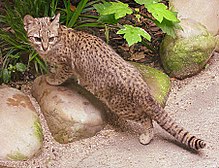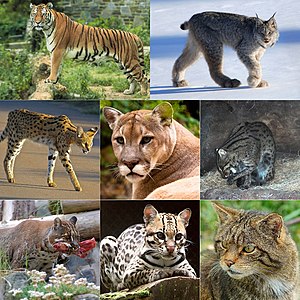Portal:Cats
Portal:Cats
|
Felidae (/ˈfɛlɪdiː/) is the family of mammals in the order Carnivora colloquially referred to as cats. A member of this family is also called a felid (/ˈfiːlɪd/). The term "cat" refers both to felids in general and specifically to the domestic cat (Felis catus). The 41 extant Felidae species exhibit the greatest diversity in fur patterns of all terrestrial carnivores. Cats have retractile claws, slender muscular bodies and strong flexible forelimbs. Their teeth and facial muscles allow for a powerful bite. They are all obligate carnivores, and most are solitary predators ambushing or stalking their prey. Wild cats occur in Africa, Europe, Asia and the Americas. Some wild cat species are adapted to forest and savanna habitats, some to arid environments, and a few also to wetlands and mountainous terrain. Their activity patterns range from nocturnal and crepuscular to diurnal, depending on their preferred prey species. (Full article...)  Geoffroy's cat (Leopardus geoffroyi) is a small wild cat native to the southern and central regions of South America. It is about the size of a domestic cat. It is listed as Least Concern on the IUCN Red List because it is widespread and abundant over most of its range. (Full article...)
The Turkish Van is a semi-long-haired, standardised breed of domestic cat, which was developed in the United Kingdom from a selection of cats obtained from various cities of modern Turkey, especially southeast Turkey. The breed is rare, is one of the larger breeds, and is distinguished by the Van pattern (named after the breed), where the colour is restricted to the head and the tail, and the rest of the cat is white; this is due to the expression of the piebald white spotting gene, a type of partial leucism. A Turkish Van may have blue or amber eyes, or be odd-eyed (having one eye of each colour). The breed was first recognised as such by a breeder/fancier organisation, the UK-based Governing Council of the Cat Fancy (GCCF), in 1969, under the name Turkish cat. It was later renamed Turkish Van to better distinguish it from the Turkish Angora breed. The Turkish Van has been claimed to be descended from (and is often confused with) the landrace of usually all-white Van cats, mostly found near Lake Van, though one of the two original breeders' own writings indicate clearly that none of the breed's foundation cats came from the Van area. (Full article...)
The following Wikimedia Foundation sister projects provide more on this subject:
Discover Wikipedia using portals |























